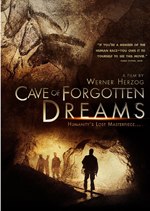Along the Ardeche River in France, archeologists discovered a vast cave system that had been sealed off for tens of thousands of years. Inside they found pristine cave paintings that seem as if they were created yesterday. The drawings of animals display artistry and imagination. Multiple legs represent movement. One strange drawing shows a bison embracing a naked woman. What were our ancient ancestors thinking? Filmmaker Werner Herzog tries to delve into the question and what it means to us today.
Herzog, who seems fascinated with extreme locations as evident in his Antarctic doc ENCOUNTERS AT THE END OF THE WORLD, talks with scientists and scholars and discovers things the cave drawings have revealed, such as the lions of the time did not have manes, which was previously unknown. Since being sealed up nearly 25,000 years ago, skulls such as cave bears have been covered in calcification, making it resemble an ivory statute. We also learn something about the artistic intentions of the people. Herzog films in 3-D to try and capture how the ancient artists even used the contours of the walls in how they approached their paintings.
These being the oldest paintings in existence the French government has limited access to the cave to perverse it. The opening has been sealed off with a giant steel door. Carefully constructed walkways are the only access through the cave. There are animal remains there, but no human bones have been found. This doesn't seem to be a place where people lived. It seems to have been a museum of sorts.
Limited in his access, Herzog and three crewmembers were given the ability to film with four cold-panel lights, powered from battery belts, and hand-held cameras. Herzog, who provides the voice over, proposes that their flickering lights across the walls might have been similar to the flickering torch lights upper Paleolithic Era humans had when they visited there. Evidence of them stoking their torches on the walls to rekindle the flame is there.
Carbon dating of some of the drawings dates them back 32,000 years and others 2,000 years after that. Just think about that. How much has happened in the past 2,000 years from today. Those who drew the original drawings were vastly different people than the ones that came after — just as we are vastly different from people who lived in Biblical times. In red palm prints on the walls, one individual stands out because he has a crooked pinkie finger. A bit of his identity has survived 32 millennia. Any of us will be lucky to simply to be remembered in three generations from now. There might be a record of us, but will a person 32 millennia from now be marveling at our crooked bones?
This is where Herzog brings the film back to us. His film and any other art is a form of communication not only to our contemporaries, but also to the future as long as it can survive. One scholar tells a story of an aborigine who sees a stone painting fading and is saddened. A Westerner is startled when the aborigine decides to repaint the painting. The Westerner asks him why he is painting and the aborigine says that it is not he who is doing it but the spirit of the original painter guiding his hand so that he can continue to speak. This is what Herzog is doing as well.










